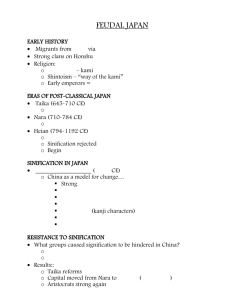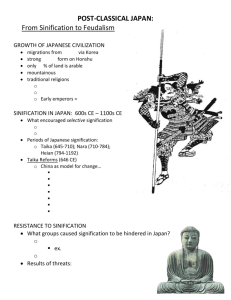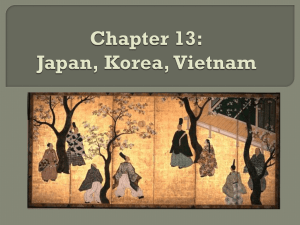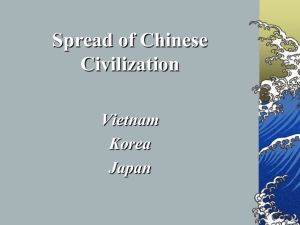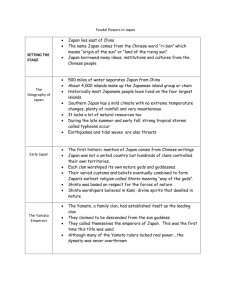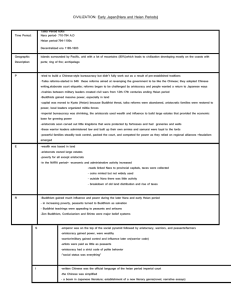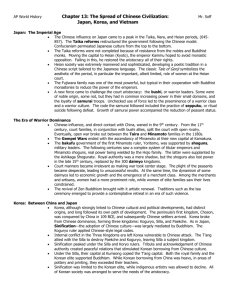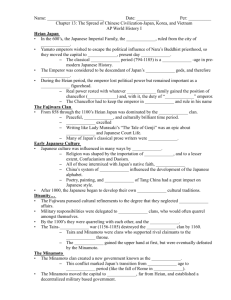AP World History Chapter 13
advertisement
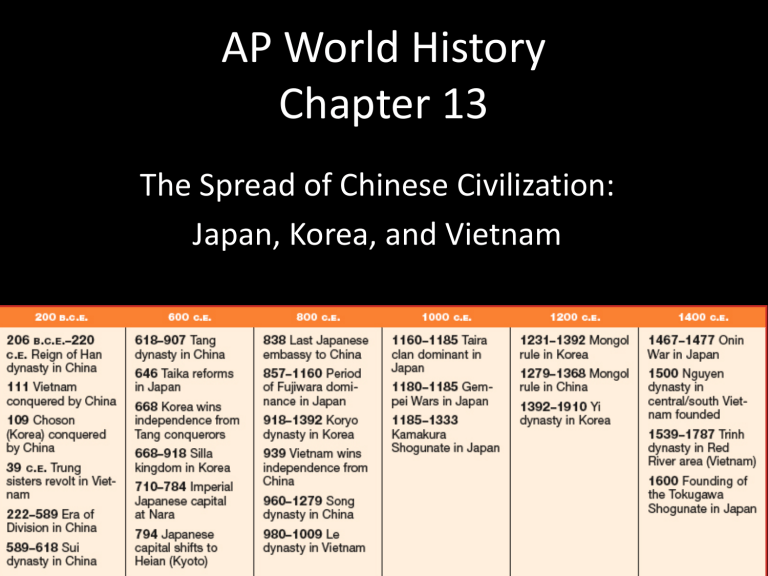
AP World History Chapter 13 The Spread of Chinese Civilization: Japan, Korea, and Vietnam The Imperial Age Taika, Nara, and Heian (7th to 9th centuries) • Borrowing from China at height Taika Reforms • • • Copy Chinese style of rule, two officials sent to China during Tang. They returned with information on government. Bureaucracy, Central Government Stronger Opposed by aristocracy, Buddhist monks Heian Period • • • • Capital to Heian (Kyoto) Abandons Taika reforms Aristocracy restored to power During the Heian the Fujiwara clan married their daughters to the heirs to the throne, thus ensuring their authority. • The pleasure loving emperors lost control of policy to aristocratic court families. • This loss of control led to Japanese Feudalism. Court Life in the Heian Era • • • • • • Court culture Codes of behavior Aesthetic enjoyment Poetry Women and men take part Lady Murasaki, Tale of Genji The Decline of Imperial Power • Fujiwara family – Dominate government – Cooperate with Buddhists – Elite cult • Regional lords (bushi) – Fortress bases – Semi-independent – Samurai • Warrior class emerges – Martial arts esteemed – Special code – Family honor – Death rather than defeat – Seppuku or hari-kiri • Peasants lose status, freedom – Salvationist Buddhism The Era of Warrior Dominance • By the 11th and 12th centuries – Family rivalries dominate – Taira, Minamoto • The Declining Influence of China – 838, Japanese embassies to China stopped – Gempei Wars – 1185, Minamoto victorious – Bakufu, military government – Kamakura, capital The Breakdown of Bakufu Dominance and the Age of the Warlords Yoritomo • Minamoto leader • Assassinates relatives • Death brings succession struggle Hojo family • Minamoto, emperor figureheads Ashikaga Takuaji • Minamoto • 14th century, overthrows Kamakura rule • Ashikaga Shogunate established • Emperor driven from Kyoto • Struggle weakens all authority Japanese Feudalism: 1467-1477, civil war among Ashikaga factions • The Age of Warlords divided Japan into 300 small states each ruled by a different Warlord. • The Emperor lost more control to the Shogons. • Toward Barbarism? • Military Division and Social Change • Warfare becomes more brutal • Daimyo support commerce • Artistic Solace for a Troubled Age • Zen Buddhism – Important among elite – Point of contact with China Korea: Between China and Japan • Separate, but greatly influenced • Ancestors from Siberia, Manchuria • By 4th century B.C.E., farming, metalworking Tang Alliances and the Conquest of Korea • 109 B.C.E., Choson kingdom conquered by Han – Silla, Paekche • Koguryo people – Resist Chinese dominance • Sinification increases after fall of the Han – Buddhism an important vehicle • Sinification: The Tributary Link • Silla, Koryo dynasties (668-1392) – Peak of Chinese influence – Silla politically independent Koryo Collapse, Dynastic Renewal Revolts • Caused by labor, tax burdens • Weaken Silla, Koryo governments 1231, Mongol invasion • Followed by turmoil 1392, Yi dynasty founded • Lasts until 1910 The Making of Vietnam, Chinese push south to Red River valley Chinese push south to Red River valley Viets • Retain distinctiveness Qin • Raid into Vietnam, 220s B.C.E. • Commerce increased • Viets conquer Red River lords Merge with Mon-Khmer, Tai Culture distinct from China • Women generally have higher status Conquest and Sinification • Han • Expand, Vietnam becomes a tributary • from 111 B.C.E., direct control • Chinese culture systematically introduced The Making of Vietnam Roots of Resistance • Resistance from aristocracy, peasants • Women participate • 39 C.E., Revolt of Trung sisters Winning Independence and Continuing Chinese Influences • Distance from China helps resistance • Independence by 939 until 19th century • Le Dynasty (980-1009) – Using Chinese-style bureaucracy The Making of Vietnam The Vietnamese Drive to the South • Indianized Khmer • Defeated, Viets expand into Mekong delta region Expansion and Division Hanoi • Far from frontiers • Cultural divisions develop following intermarriage with Chams, Khmers Nguyen dynasty • Capital at Hue, by late 1500s • Challenge Trinh in North • Rivalry until 18th century
